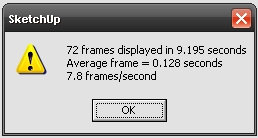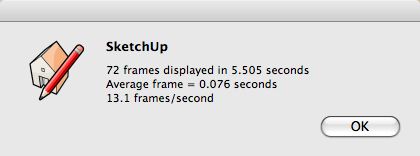Let's have a Hardware speed test for SU
-
Looking at the results, it appears that SU is very graphics card dependent. I saw the 8 cores and thought it was going to stomp most everything, but no:

I only have a dual core, but the graphics cards are in SLi:


Just built this at the end of last year, 4 GB OCZ mem on WinXP, EVGA 780i FTW, nothing overclocked.
-
Remember, you can have a 64 core machine and SU will only use the first one, so the highest clockspeed single core machine in theory should be better, then again a good graphics card should also help matters as far as frame rates go.
Now if we had a scene with some taxing textures, shadows included too, that would be interesting. -
A computer doesn't need to be any faster than you can type, I always say.
Update - this is without shadows, which are basically unusable for me.

-

-
Good point Remus...I turned "shadows" on and got this (pretty consistly):

-
@solo said:
Remember, you can have a 64 core machine and SU will only use the first one...
Good point, I keep forgetting that SU will not take advantage of multiple cores. Must be the only program on my computer that will not..

-
Turned "shadows" on , I got it
I have a problem.
solo (i7 940, 12GB ram, gtx 280) he got 16.6 F/s
Gaieus ( 2Gb RAM and 6800 GO video card.) he got 12.6 F/sGaieus's performance is quite less than solo's , but Gaieus's mark is close to solo's. Why ?
-
I believe the answer lies in the fact that Gaieus has a single core clocked at 3.8Ghz verses a single core on mine at 2.93Ghz giving him superior performance on CPU usage but his let down is the weaker integrated GPU (video card). Had Gaieus had a new 1GB card he would kill my score, or if I was to overclock my CPU's to say 4.2Ghz my score would skyrocket.
-
This is with an AMD Athlon 64 X2 Dual Core 2.01 Ghz, 1 Gb of Ram, ATI Radeon ASUS X1550 512 Mb.

-
@solo said:
...Had Gaieus had a new 1GB card he would kill my score, or if I was to overclock my CPU's to say 4.2Ghz my score would skyrocket.
Well, it's unlikely that I'm going to upgrade this old lappy (quite good one for a laptop however!) but true,some more power on the video card end would probably help.
Although a single core, my processor is capable of hyperthreading - AFAIK an experimental technology that started along with multi cores and seem to "come back" with i7's and such (like Pete's) - so I'm quite satisfied with it as it has a good clock speed (not overclocked though) for SU but when it comes to rendering for instance, it's doing it on two (virtual) cores.
Certainly when doing such tests with heavy materials and shadows on, the drawbacks of the relatively weak video card are apparent.
-
phoa..my computer is very slow.. i think my problem is memory i have only 1 gb(graphic card 1gb nvidia 8600gt,processor pentium dual core 2.8 ghz)
here is the test with shadow on..and with shadow off it was about 8.7 sec

-
it seams that sketchup depends on cpu clock more than videocard performance and multicore cpu
-
here we go - Windows XP 32bit SR3 - I'll boot into Windows 7 64 later and post a test from there.

-
A MacBook Pro weighs in...




-
I'm at home today on my old G4 Mac Laptop.
Yikes ...I'd test with shadows on, but I can't afford to take a couple of hours off.
Have to try on my work machines tomorrow.


-
Ok, here,s mine, a 2.5 years white macbook:



-
14.0 frames/sec
Which is annoying since i bought a £600 Quadro FX3700. Probably better off with a game card.
Rest of the system
CPU i7 720
6G Ram -
maybe Quadro or FireGl can get hight score
-
@unknownuser said:
maybe Quadro or FireGl can get hight score
That IS the result with a Quadro card.
-
My MacBook Pro has exactly the same spec as troyhome.
2.93 Duo
9600 GTP.S I love this machine


Advertisement







